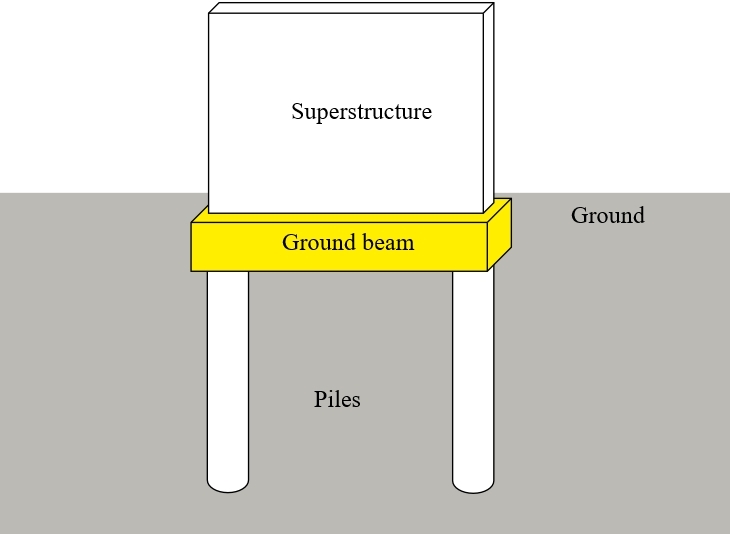Ground beams in construction
Beams are structural elements that transfer loads imposed along their length to their end points where the loads are transferred to walls, columns, foundations, and so on.
Ground beams are beams that are designed to span between pad foundations, piles and so on, as an alternative to traditional foundations.

|
Ground beams are generally constructed from concrete, and for low-rise buildings are commonly constructed in situ, however, as this can be relatively time-consuming method, the use of precast concrete ground beams has increased.
The advantages of using ground beams are that they are quicker to install than conventional footings, and allow uncertainties regarding ground conditions to be overcome. They also create a very accurate bearing level, reducing the amount of levelling up that is required prior to starting to build up the superstructure.
Ground beams may be used to support brick work, block work and so on, but may also be used at the edge of in situ concrete floor slabs, where they form permanent shuttering. They tend to be square or rectangular in section, and can be designed to incorporate notches, end details and sloping faces.
Precast ground beams are cast to the required lengths in an off-site factory and are then lowered into place on site, typically spanning between the tops of piles. Small in situ concrete ‘stitches’ are used to connect and bolt the beams securely to each other and the piles. Secondary beams can also be connected to the ground beam system to form a beam and block ground floor.
[edit] Find out more
[edit] Related articles on Designing Buildings Wiki
Featured articles and news
RTPI leader to become new CIOB Chief Executive Officer
Dr Victoria Hills MRTPI, FICE to take over after Caroline Gumble’s departure.
Social and affordable housing, a long term plan for delivery
The “Delivering a Decade of Renewal for Social and Affordable Housing” strategy sets out future path.
A change to adoptive architecture
Effects of global weather warming on architectural detailing, material choice and human interaction.
The proposed publicly owned and backed subsidiary of Homes England, to facilitate new homes.
How big is the problem and what can we do to mitigate the effects?
Overheating guidance and tools for building designers
A number of cool guides to help with the heat.
The UK's Modern Industrial Strategy: A 10 year plan
Previous consultation criticism, current key elements and general support with some persisting reservations.
Building Safety Regulator reforms
New roles, new staff and a new fast track service pave the way for a single construction regulator.
Architectural Technologist CPDs and Communications
CIAT CPD… and how you can do it!
Cooling centres and cool spaces
Managing extreme heat in cities by directing the public to places for heat stress relief and water sources.
Winter gardens: A brief history and warm variations
Extending the season with glass in different forms and terms.
Restoring Great Yarmouth's Winter Gardens
Transforming one of the least sustainable constructions imaginable.
Construction Skills Mission Board launch sector drive
Newly formed government and industry collaboration set strategy for recruiting an additional 100,000 construction workers a year.
New Architects Code comes into effect in September 2025
ARB Architects Code of Conduct and Practice available with ongoing consultation regarding guidance.
Welsh Skills Body (Medr) launches ambitious plan
The new skills body brings together funding and regulation of tertiary education and research for the devolved nation.
Paul Gandy FCIOB announced as next CIOB President
Former Tilbury Douglas CEO takes helm.
UK Infrastructure: A 10 Year Strategy. In brief with reactions
With the National Infrastructure and Service Transformation Authority (NISTA).






















